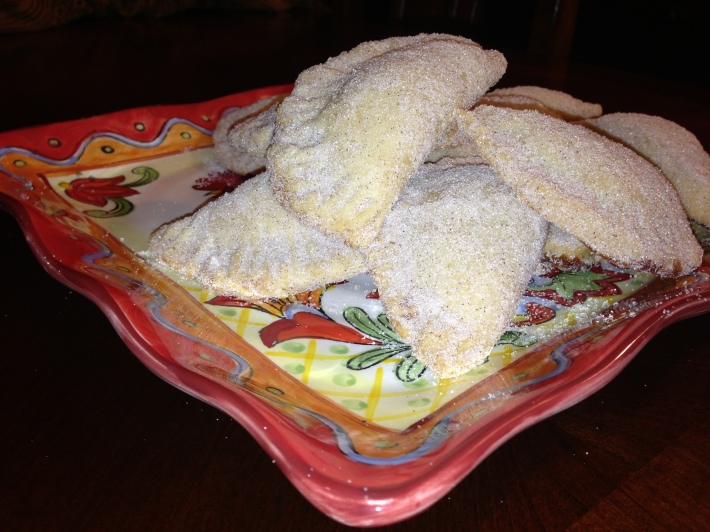As a child, I looked forward to making empanadas with my mother because I was always welcome to take on small tasks in the creation process of these deliciously, sweet-filled pastries. My favorite part was helping my mother cover the empanadas in sugar and cinnamon once they were out of the oven because this meant that they were almost ready to eat. At this point, all that was left was to wait for them to further cool down. While I anxiously waited, I would consider cracking one open to facilitate the cooling process, but then I would quickly remind myself of the rewarding feeling that came with biting into a whole empanada. First, I could cover my lips with the sugar and cinnamon before biting into the delicately crumbling, textured bread, and finally coming across the sweet gooey strawberry jam with which my mom most often filled our empanadas. Empanadas taught me the value of patience!
While studying abroad in Argentina, I was surprised by the empanadas that were no longer a dessert, but creatively filled with meat, cheese or vegetables. It was my first time coming across such empanadas and I struggled with the idea of eating empanadas at the beginning of a meal. Not until I found Cumana Restaurant’s savory, but mouth-watering empanadas in Buenos Aires was I able to let go of my nervousness of eating something so similar yet opposite to what I was used to.
After my encounter with empanadas in Argentina, I was open to the idea that empanadas exist in different forms across the world. The songpyeon that I attempted to make several months ago also struck me as empanada-like, and I found comfort in approaching something so unfamiliar to me in the routine way that I would make empanadas with my mother. These half-moon rice cakes that were sticky and chewy on the outside with an inner delicate sweet bean paste ended up not having much in common with my empanadas, but I nonetheless found warmth and ease in relating this Korean dessert to empanadas.
Below is my mother’s recipe for Strawberry Jam filled Empanadas which makes slightly over 1 dozen empanadas. Please remember that you are welcome to fill the empanada with whatever you like.
Strawberry Jam Empanadas

Ingredients:
2 cups flour
½ teaspoon salt
1 cup all vegetable shortening
5-7 tablespoons cold water
strawberry jam
¼ cup cinnamon
1 cup sugar
Materials:
rolling pin
1 large bowl
1 small bowl
measuring cups
measuring spoons
plastic bag
baking pan
1) Mix 2 cups of flour with ½ teaspoon of salt in a large bowl.
2) Add 1 cup of all vegetable shortening to the bowl and mix.
3) While mixing the ingredients to make the dough, add 1 tablespoon at a time (out of the 5-7 tablespoons) of cold water to the bowl.
4) Knead the dough into a ball and place in a plastic bag.
5) Set this bag aside for 30 minutes.
6) Preheat the oven to 350 degrees Fahrenheit.
7) After 30 minutes have passed, take the dough out of the bag.
8) Form a small ball that is about half the length and width of your palm.
9) Use a rolling pin to roll out the dough into a flat circle. It is okay if the circle is not perfectly round.
10) Add 1 tablespoon of strawberry jam to the middle upper half of the circle.
11) Fold the circle into a half moon shape by pulling the dough over.
12) Cut some of the dough off while leaving a border edge from the dough that is not filled with jam.
13) Press the border edge down lightly and with a fork press down to decorate the border.
14) Place your empanada on a greased pan.
15) Repeat steps 8 – 14 until you have used up all the dough.
16) Place pan in oven to bake for 35 minutes at 350 degrees Fahrenheit.
17) Combine sugar and cinnamon in bowl, mix, and set aside.
18) Remove empanadas from the oven when they are a light golden brown and allow to cool for 5 minutes.
19) Roll empanadas in sugar and cinnamon mixture one at a time. Set aside to allow to cool for another 10 minutes.




